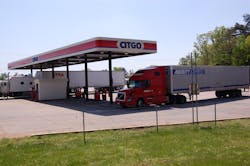The national average retail price for diesel dropped this week, according to data tracked by the Energy Information Administration (EIA), while gasoline prices ticked upward both nationally and regionally.
Diesel declined a penny this week to a national retail average of $2.389 per gallon, EIA noted, though that’s 10.4 cents per gallon cheaper when compared to the same week in 2015.
Prices for diesel dropped in all U.S. regions, the agency added, dipping the most on the West Coast – sans California’s prices – by 2.9 cents to $2.524 per gallon. With California’s prices included, diesel only fell 1.4 cents to $2.652 per gallon on the West Coast this week.
By contrast, the national average retail price for gasoline jumped 2.3 cents to $2.225 per gallon, largely due to a pipeline break in Alabama. Despite that price spike, though, the national retail average for gasoline is still 10.2 cents cheaper per gallon compared to the same week in 2015, EIA noted.
Gasoline prices in almost every region of the U.S. increased this week, the agency noted, falling in only two areas:
- The Gulf Coast: down 6/10ths of a penny to $1.967 per gallon (the only region in the country where gasoline is below the $2 per gallon mark)
- The Rocky Mountains: down 8/10ths of a penny to $2.265 per gallon
Prices increased in every other U.S. region this week, EIA noted with the biggest spike a 7.7 cent per gallon surge in the Lower Atlantic, where gasoline is now an average of $2.172 per gallon; a spike that helped push average gasoline prices for the East Coast up 4.5 cents to $2.192 per gallon.
The EIA also noted that the U.S. is now “simultaneously” importing and exporting gasoline due to “regional differences” in gasoline supply and demand balances.
The two regions with the largest supply and demand imbalances are the East Coast, which imported 581,000 barrels per day (b/d) of gasoline in 2015, and the Gulf Coast, which exported 551,000 b/d of gasoline in 2015.
Those regional supply and demand balances, described in the agency’s recent PADD 1 and PADD 3 Transportation Fuels Markets report, are partially due to refining capacity that is below consumption rates on the East Coast (tagged Petroleum Administration for Defense District 1 or “PADD 1”). Thus to meet demand, gasoline must be shipped in from other parts of the U.S. as well as from international sources for that region.
By contrast, refining capacity in the Gulf Coast (PADD 3) exceeds demand, allowing the region to send gasoline elsewhere in the U.S. as well as internationally.
Patterns of international trade in gasoline in all U.S. regions are also affected by transportation constraints and shipping regulations. Pipelines between the Gulf Coast and East Coast already operate at or near full capacity, while maritime regulations can add significantly to the cost of marine movements between U.S. ports, the agency noted
The East Coast had the highest gasoline consumption in the country at 3.2 million b/d in 2015, the EIA said, though refinery production in the region topped only 550,000 b/d in 2015.
To meet demand, the East Coast receives gasoline via pipeline and marine shipment from Gulf Coast refineries, the agency pointed out, with approximately 1.9 million b/d of gasoline, or 60% of East Coast gasoline demand, coming from the Gulf Coast in 2015.
The East Coast also imports gasoline from other countries, predominantly Western Europe and Canada; volume that accounted for 87% of total U.S. gasoline imports in 2015, the agency said.
About the Author
Sean Kilcarr
Editor in Chief
Sean Kilcarr is a former longtime FleetOwner senior editor who wrote for the publication from 2000 to 2018. He served as editor-in-chief from 2017 to 2018.
